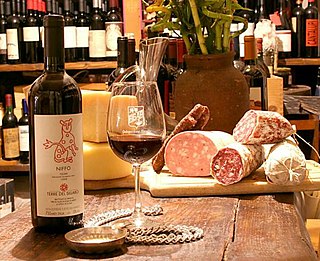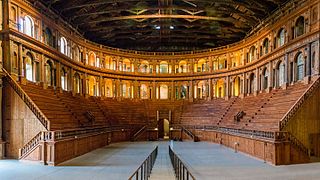
Chianti is an Italian red wine produced in the Chianti region of central Tuscany, principally from the Sangiovese grape. It was historically associated with a squat bottle enclosed in a straw basket, called a fiasco. However, the fiasco is now only used by a few makers of the wine; most Chianti is bottled in more standard-shaped wine bottles. In the latter nineteenth century, Baron Bettino Ricasoli helped establish Sangiovese as the blend's dominant grape variety, creating the blueprint for today's Chianti wines.

Salami is a cured sausage consisting of fermented and air-dried meat, typically pork. Historically, salami was popular among southern, eastern, and central European peasants because it can be stored at room temperature for up to 45 days once cut, supplementing a potentially meager or inconsistent supply of fresh meat. Countries and regions across Europe make their own traditional varieties of salami.

Soppressata is an Italian dry salume. Although there are many variations, two principal types are made: a cured dry sausage typical of Basilicata, Apulia, and Calabria, and a very different uncured salami, made in Tuscany and Liguria. It is still part of southern Italian cultural heritage that local people slaughter the pig themselves and use it all, with nothing going to waste, using some parts to make cured meats, including soppressata. It is sometimes prepared using ham.

Salumi are Italian meat products typical of an antipasto, predominantly made from pork and cured. Salumi also include bresaola, which is made from beef, and some cooked products, such as mortadella and prosciutto.

Teatro Farnese is a Renaissance theatre in the Palazzo della Pilotta, Parma, Italy. It was built in 1618 by Giovanni Battista Aleotti. The idea of creating this grand theater came from the Duke of Parma and Piacenza Ranuccio I Farnese. It was part of the complex of the Ducal Palace of Parma. The theatre was almost destroyed by an Allied air raid during World War II (1944). It was rebuilt and reopened in 1962.

Alfonso Alonso Blasco, commonly known as Sito Alonso, is a Spanish basketball coach who is the head coach for UCAM Murcia of the Spanish Liga ACB.

Duke or Duchess San Donato was a noble title, first created in 1602 by the Spanish King Philip III for the House of Sanseverino. The duchy was traditionally based on estates and territories held in San Donato di Ninea, Calabria. The first creation, however, lasted only 52 years. In 1668, the title was recreated for a wealthy merchant, Antonio Amitrano, who had some years earlier bought the feudal rights over the former dukes' territories. Descendants of the Ametrano family held the duchy, as one several titles, until it became extinct in the 1970s. There have been successive claims over the centuries by distant kinsmen of the first holders to claim the duchy; these remain unverified.

Miroglio is an Italian firm specialising in the manufacture and distribution for sale of ready-to-wear clothing. Incorporated in Alba, Piedmont, Cuneo, Italy, the Group has 30 business operations in 41 countries and 1,100 branded stores.

MYmovies.it is a website dedicated to Italian cinema. Established in 2000, the website contains a database on Italian films and television series and actors with films from 1895 to present. The website also features reviews of up and coming films, interviews with actors and directors and other notable figures in the Italian film industry and international news related to film. In 2010, it also launched a streaming platform, Mymovieslive!. The website is particularly popular among Italian men aged 25 to 45 according to demographic surveys and is the 56th most popular website with Internet users from Italy.

A Superior Graduate School is a completely independent institution from a legal point of view, which offers advanced training and research through university-type courses or is dedicated to teaching at graduate or post-doctoral level.

The Tomb of Priscilla is a monumental tomb erected in the first century in Rome on the Appian Way, situated opposite the Church of Domine Quo Vadis.
Enrico Martinelli was an Italian trumpet player, teacher and composer.

Palazzo Giustiniani or the Piccolo Colle is a palace on the Via della Dogana Vecchia and Piazza della Rotonda, in Sant'Eustachio, Rome.

Costantino della Gherardesca Verecondi Scortecci, or simply Costantino della Gherardesca, is an Italian actor, journalist, radio presenter, television personality and presenter.
The awards for Civil Valor are the honors the Italian Republic grants in order to "reward acts of exceptional courage that clearly manifest civic virtue and to recognize the recipients as worthy of public honor". Individual citizens can receive the award, and it can also be bestowed collectively on all members of a military department or all residents of a municipality, city, or province when they have knowingly exposed their life to manifest danger.

A Ministry of the Republic of Italy is an administrative organ of the Republic of Italy, placed at the top of Italian public administration and is characterised by one or more specific competencies, with an organised structure, often varying over time.

Maria Rita Brondi was an Italian guitarist, lutenist, singer, composer, and music historian.

Santa Maria Bianca Hospital is a community hospital located in Mirandola, in the province of Modena, in Emilia-Romagna, Italy.

Ligurian cuisine consists of dishes from the culinary tradition of Liguria, a region of northwestern Italy, which makes use of ingredients linked both to local production, and to imports from areas with which, over the centuries, the Ligurians have had frequent trade.

Salame Felino is a variety of Italian salume historically produced in the comune (municipality) of Felino and in some neighboring comuni, such as Sala Baganza and Langhirano, all in the province of Parma. It is recognised as a protected geographical indication (PGI).


















